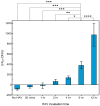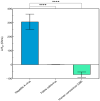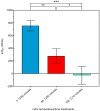A Cell-Based Electrochemical Biosensor for the Detection of Infectious Hepatitis A Virus
- PMID: 39727841
- PMCID: PMC11726883
- DOI: 10.3390/bios14120576
A Cell-Based Electrochemical Biosensor for the Detection of Infectious Hepatitis A Virus
Abstract
Hepatitis A virus (HAV), a major cause of acute liver infections, is transmitted through the fecal-oral route and close contact with infected individuals. Current HAV standardized methods rely on the detection of virus antigen or RNA, which do not differentiate between infectious and non-infectious HAV. The objective of this study was to develop a prototype cell-based electrochemical biosensor for detection of infectious HAV. A cell culture-adapted HAV strain (HM175/18f) and its permissive cells (FRhK-4), along with gold nanoparticle-modified screen-printed electrodes, were used to develop the biosensor. Electrochemical impedance spectroscopy was used to quantify the electrical impedance signal. Nyquist plots showed successful fabrication of the cell-based biosensor. The optimum period of HAV incubation with the biosensor was 6 h. A significant linear relationship (R2 = 0.98) was found between the signal and a 6-log range of HAV titers, with a limit of detection of ~5 TCID50/mL (tissue culture infectious dose). The biosensor did not detect non-target viruses such as feline calicivirus and human coronavirus 229E. The biosensor was stable for 3 to 7 days at an abusive temperature (37 °C), retaining ~90 to 60% of the original signal, respectively. In conclusion, this prototype cell-based biosensor is capable of rapidly detecting low levels of infectious HAV.
Keywords: FRhK-4 cells; Hepatitis A virus; cell-based biosensors; foodborne outbreaks; impedance spectroscopy; infectious viruses; infectivity assay; screen-printed electrodes.
Conflict of interest statement
The authors declare no conflicts of interest. The funders had no role in the design of the study; in the collection, analyses, or interpretation of data; in the writing of the manuscript; or in the decision to publish the results.
Figures








Similar articles
-
Development of a Real-Time Cell Analysis (RTCA) Method as a Fast and Accurate Method for Detecting Infectious Particles of the Adapted Strain of Hepatitis A Virus.Front Cell Infect Microbiol. 2018 Sep 25;8:335. doi: 10.3389/fcimb.2018.00335. eCollection 2018. Front Cell Infect Microbiol. 2018. PMID: 30319992 Free PMC article.
-
Rapid and label-free electrochemical DNA biosensor for detecting hepatitis A virus.Biosens Bioelectron. 2018 Feb 15;100:89-95. doi: 10.1016/j.bios.2017.08.043. Epub 2017 Aug 19. Biosens Bioelectron. 2018. PMID: 28865923
-
Detection of infectious hepatitis A virus by integrated cell culture/strand-specific reverse transcriptase-polymerase chain reaction.J Appl Microbiol. 2004;97(5):1105-12. doi: 10.1111/j.1365-2672.2004.02413.x. J Appl Microbiol. 2004. PMID: 15479428
-
[Hepatitis A virus infection. A review].Praxis (Bern 1994). 2003 Oct 1;92(40):1659-73. doi: 10.1024/0369-8394.92.40.1659. Praxis (Bern 1994). 2003. PMID: 14579471 Review. German.
-
Foodborne transmission of hepatitis A and hepatitis E viruses: A literature review.Int J Food Microbiol. 2021 Jan 2;338:108986. doi: 10.1016/j.ijfoodmicro.2020.108986. Epub 2020 Nov 19. Int J Food Microbiol. 2021. PMID: 33257099 Review.
Cited by
-
Electrochemical Impedance Spectroscopy-Based Biosensors for Label-Free Detection of Pathogens.Biosensors (Basel). 2025 Jul 10;15(7):443. doi: 10.3390/bios15070443. Biosensors (Basel). 2025. PMID: 40710093 Free PMC article. Review.
-
An electrochemical biosensor for the detection of microRNA-31 as a potential oral cancer biomarker.J Biol Eng. 2025 Mar 25;19(1):24. doi: 10.1186/s13036-025-00492-1. J Biol Eng. 2025. PMID: 40133958 Free PMC article.
-
Perspectives on the Application of Biosensors for the Early Detection of Oral Cancer.Sensors (Basel). 2025 Feb 27;25(5):1459. doi: 10.3390/s25051459. Sensors (Basel). 2025. PMID: 40096320 Free PMC article. Review.
References
-
- CDC Widespread Hepatitis A Outbreaks Associated with Person-to-Person Transmission—United States, 2016–2020. [(accessed on 20 August 2024)]; Available online: https://www.cdc.gov/mmwr/volumes/71/wr/mm7139a1.htm.
MeSH terms
Substances
Grants and funding
LinkOut - more resources
Full Text Sources

